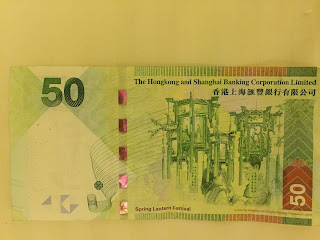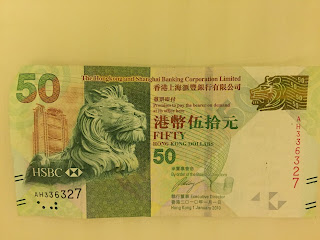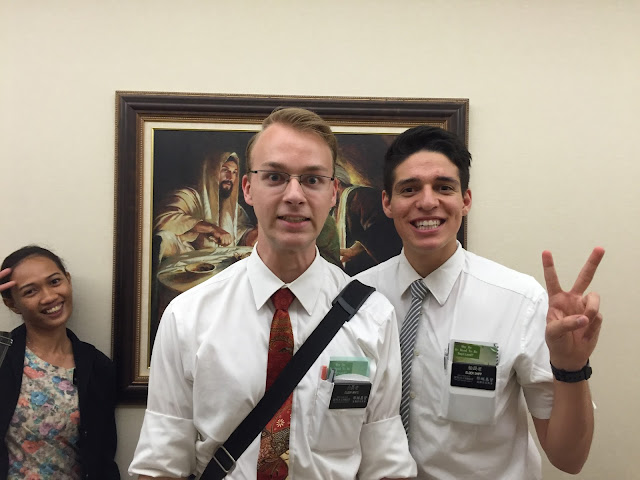 |
Do you have any money to burn? The Chinese do as you can read in Wikipedia:
"H..." money is a form of joss paper printed to resemble legal tender bank notes. The notes are not an officially recognized currency or legal tender since their sole intended purpose is to be offered as burnt-offerings to the deceased as often practiced by the Chinese and several East Asian cultures. This faux money has been in use since at least the late 19th century and possibly much earlier. Early 20th century examples took the resemblance of minor commercial currency of the type issued by businesses across China until the mid-1940s.[1]
The identification of this type of joss paper as "hell bank notes" or "hell money" and singling them out is largely a Western construct, since these items are simply regarded as yet another form of joss paper (冥幣, 陰司紙, 紙錢, or 金紙) in East Asian cultures and have no special name or status.
he word hell on hell bank notes refers to Diyu (simplified Chinese: 地狱; traditional Chinese: 地獄; pinyin: dìyù, "underworld prison"; also 地府, dìfǔ, "underworld court"). These words are printed on some notes. In traditional Chinese belief, it is thought to be where the souls of the dead are first judged by the Lord of the Earthly Court, Yan Wang. After this particular judgement, they are either escorted to heaven or sent into the maze of underworld levels and chambers to atone for their sins. People believe that even in the earthly court, spirits need to use money.[2]
A popular story says that the word hell was introduced to China by Christian missionaries, who preached that all non-Christian Chinese people would "go to hell" after death. The word "Hell" was thus misinterpreted to be the proper English term for the afterlife and hence adopted as such. Some printed notes attempt to correct this by omitting the word "hell" and sometimes replacing it with "heaven" or "paradise". These particular bills are usually found in joss packs meant to be burned for Chinese deities, and usually have the same design as hell bank notes but with different colours.
Designs
Earlier examples of these notes were issued in denominations of 5 and 10 yuan and upwards, with such amounts being considered adequate until inflation took hold within China from 1944. The soaring denominations of authentic currency was soon reflected in that issued for the afterlife, and after 1945 the majority of Hell banknotes were issued in denominations of $10,000 or higher. These earlier issues more commonly depict landscape scenes, temples or trains, and the numerous varieties may literally number into the millions.[3]
Modern Hell bank notes are known for their large denominations, ranging from $10,000 to several billions. The obverse usually bears an effigy of the Jade Emperor, the presiding monarch of heaven in Taoism; his signature, romanised as Yu Wong or Yuk Wong; and the countersignature of Yanluo, King of Hell (閻羅). There is usually an image of the Bank of Hell on the reverse of the notes.
A commonly sold Hell bank note is the $10,000 note that is styled after the old United States Federal Reserve Note. The obverse contains, apart from the portrait of the Jade Emperor, the seal of the Bank of Hell consisting of a picture of the bank itself. Many tiny, faint "Hell Bank Note"s are scattered on the back in yellow. These are sold in packs of 50 to 150, and are wrapped in cellophane.
Stores that specialize in selling ritual items, such as the religious goods stores in Malaysia, also sell larger and elaborately decorated notes that have a larger denomination than the usual $10,000 note. Some bills do not portray the Jade Emperor, and portray other famous figures from Chinese mythology instead, such as the Eight Immortals, the Buddha, Yama, or images of dragons. Some even portray famous people who are deceased, such as US President John F. Kennedy, Albert Einstein and Marilyn Monroe.
Customs
When burning the notes, the notes are placed as a loose bundle, in a manner considered respectful. Alternatively, in some customs, each bank note may be folded in a specific way before being tossed into the fire because of the belief that burning real money brings bad luck.
|
 |
| Here's some that one of the Filipino sisters bought and took a photo of just for fun. |
 |
| Here's what someone else wrote on their blog about this money:Afterlife note |
If you want to read about the real money in Hong Kong and who prints it (Here it isn't the Federal Reserve), you can go to this site:Hong Kong Money
 |
Here's the front and back of Hong Kong ten dollars worth $1.29. This bill actually has a circle of cellophane type stuff on it so that you can see through the bill.
|
 |
| 20 Hong Kong dollars is $2.58. |
 |
| 50 Hong Kong dollars is $6.45 |
 |
| 100 Hong Kong dollars is $12.89 |
 | ||
500 HK is $64.47 so you can see that a person can have lots of money and still not have very much money! Funny, huh? Sister Chandler still has a hard time not knowing how much money she really has or has spent!
So, after cooking today, Elder Chandler found out that the Sunday (Friday family) School teacher couldn't get off work so he also taught the lesson as he had also had to do this on Thursday, too. He's a good scout, though, as he's always prepared. (Sister Chandler had to teach last week and play the piano for the choir number today.)
After church, we held our business self-reliance class as we do on Thursdays and Fridays. Elder Chandler made up an extra worksheet where they had to actually record business transactions for his made-up ice cream business. They are cheering as they love learning all of these principles and they are getting really good at understanding how to run a small business and become more self-reliant. They work with their families in the Philippines who are learning these principles, too. Maybe next week, we'll include a couple of websites of people who took the self-reliance classes and are now running successful businesses in the Philippines.
After the self-reliance class, we ran into the missionaries who were still working hard today and going strong. Elder Chandler likes to call these two missionaries, Elder Blanco and Elder Barco which is Spanish for Elder White and Elder Shipp. They are hard-workers!
The Sister Missionaries work just as hard and long as the Elders do. These sisters are from the Philippines (except the one on the left is from Saipan).
It was actually dark tonight when we finally left the office but every time I try to remove this out-of-place photo it removes the rest of the post, so it's staying where it is. Isn't that a beautiful fountain that we usually see from the bus on the way home from work? It looks like the dandelions that have gone to seed that children like to blow.
It's the same for this photo, too, but we like the Happy Valley bus anyway and we wonder just where it is going! Our bus finally came and in the very slow traffic going home after 40 minutes to travel the two miles or so to get home, we arrived back around 7:30 pm.
|
Now we are getting ready for our self-reliance fair which we are in charge of on October 1st. That day is a national holiday so the sisters should be able to attend. Last year they had about 250 people with many non-members attending, too. We have been busy finding really good speakers and helping to design posters, etc. We are excited and this should be a wonderful event. So, everybody, let's all remember to GO FORWARD IN OUR LIVES WITH FAITH as it's all worth it, too!






















No comments:
Post a Comment